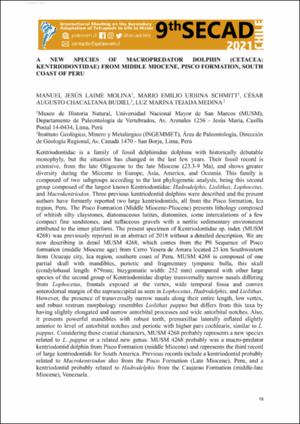- Repositorio Institucional INGEMMET
- Ponencias y Artículos científicos
- Ponencias, comunicaciones en congresos
Please use this identifier to cite or link to this item:
https://hdl.handle.net/20.500.12544/4914A new species of Macropredator Dolphin (Cetacea: Kentriodontidae) from middle Miocene, Pisco formation, South coast of Perú
2021
Kentriodontidae is a family of fossil delphinidan dolphins with historically debatable monophyly, but the situation has changed in the last few years. Their fossil record is extensive, from the late Oligocene to the late Miocene (23.3-9 Ma), and shows greater diversity during the Miocene in Europe, Asia, America, and Oceania. This family is composed of two subgroups according to the last phylogenetic analysis, being this second group composed of the largest known Kentriodontidae: Hadrodelphis, Liolithax, Lophocetus, and Macrokentriodon. Three previous kentriodontid dolphins were described and the present authors have formerly reported two large kentriodontids, all from the Pisco formation, Ica region, Peru. The Pisco Formation (Middle Miocene-Pliocene) presents lithology composed of whitish silty claystones, diatomaceous lutites, diatomites, some intercalations of a few compact fine sandstones, and tuffaceous gravels with a neritic sedimentary environment attributed to the inner platform. The present specimen of Kentriodontidae sp. indet. (MUSM 4268) was previously reported in an abstract of 2018 without a detailed description. We are now describing in detail MUSM 4268, which comes from the P0 Sequence of Pisco formation (middle Miocene age) from Cerro Yesera de Amara located 25 km Southwestern from Ocucaje city, Ica region, southern coast of Peru. MUSM 4268 is composed of one partial skull with mandibles, periotic and fragmentary tympanic bulla, this skull (condylobasal length: 679mm; bizygomatic width: 252 mm) compared with other large species of the second group of Kentriodontidae display transversally narrow nasals differing from Lophocetus, frontals exposed at the vertex, wide temporal fossa and convex anterodorsal margin of the supraoccipital as seen in Lophocetus, Hadrodelphis, and Liolithax. However, the presence of transversally narrow nasals along their entire length, low vertex, and robust rostrum morphology resembles Liolithax pappus but differs from this taxa by having slightly elongated and narrow antorbital processes and wide antorbital notches. Also, it presents powerful mandibles with robust teeth, premaxillae laterally inflated slightly anterior to level of antorbital notches and periotic with higher pars cochlearis, similar to L. pappus. Considering these cranial characters, MUSM 4268 probably represents a new species related to L. pappus or a related new genus. MUSM 4268 probably was a macro-predator kentriodontid dolphin from Pisco Formation (middle Miocene) and represents the third record of large kentriodontids for South America. Previous records include a kentriodontid probably related to Macrokentriodon also from the Pisco Formation (Late Miocene), Peru, and a kentriodontid probably related to Hadrodelphis from the Caujarao Formation (middle-late Miocene), Venezuela.
SECAD
Laime, M.; Urbina, M.; Chacaltana, C. & Tejada, L. (2021). A new species of Macropredator Dolphin (Cetacea: Kentriodontidae) from middle Miocene, Pisco formation, South coast of Perú. 9th SECAD: International Meeting on the Secondary Adaptation of Tetrapods to Life in Water. Virtual Meeting, 19-23 April 2021.
9th SECAD: International Meeting on the Secondary Adaptation of Tetrapods to Life in Water. Virtual Meeting, 19-23 April 2021
1 página
Files in This Item:
| File | Description | Size | Format | |
|---|---|---|---|---|
| Laime-A_new_species_Macropredator.pdf | Artículo de congreso | 210 kB | Adobe PDF | View/Open |
This item is licensed under a Creative Commons License












